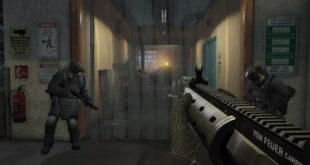For more on our behind the scenes look at Rockstar North, read parts one, two and four.
The studio leaders will tell you that the last five per cent of making a GTA – the polish – matter just as much as the first 95 per cent. But you don’t get anywhere without decent technology.
And it’s Rockstar North’s technical director Adam Fowler and associate technical director Phil Hooker that have been in charge of the enviable, if daunting, and bespoke technology that powers the worlds of Grand Theft Auto and other Rockstar games.
Everything in the GTA games – apart from stalwart tools like NaturalMotion Euphoria, Scaleform and Bink – is built using in-house streaming tech and game engine.
Fowler has been at the company for 20 years, back when it was DMA Design, starting out on Lemmings 2 for the SNES. It was him who teamed up with Benzies and art lead Garbut to devise streaming technology, an innovation that made modern GTA what it is.
“Streaming is the backbone of everything we do,” says Fowler, who was the original architect of that game and its technology.
“We made a major leap of faith that we could do it – and luckily we did. At that point we knew we had a fairly large environment, and this vague idea we’d load it all in the background,” he says.
But there was huge disbelief that the team, then just a part of DMA Design, would ever get it running. “It was a huge risk,” says Benzies, who recalls where the idea first came from. “We saw a game that had a CD running, streaming footage, but with polygons over the top – so we thought ‘What if that was footage of you driving around and it was a car overlaid?’ Adam’s a genius, he just ran off and did it, but everyone else in the studio thought we were nuts.
“And we didn’t really know it would work out in the wild. Sure, we had it running on dev kits in the office, but they weren’t retail machines – for all we knew the game would wear the home consoles out with all that disc movement. That makes you shit yourself. Without that tech there wouldn’t be GTA. We needed it to run.”
So powerful and instrumental was the innovation, says Fowler, some of the lines of code ‘have probably survived from GTA III into V in some small way’.
TOOL’S GOLD
Today, the tech principles are still the same when it comes to how the streaming works in the newer GTAs, and it is important “everyone at the company understands how it’s structured,” says Fowler.
But the volume of assets and material has changed over time. “On GTA III the game was just streaming geometry and textures from the disc. World descriptions, collisions and animations would be in system memory.”
Hooker, who joined Rockstar North in 2005 as an AI programmer before leaping up the ranks to a more senior role, adds: “The assets now are so big that pretty much everything is in a streaming state. When the game is running, it has loaded in the immediate area around the player, plus mission objects and so on, and the nav mesh for AI.”
Streaming is the backbone of everything we do. Everyone at the company understands how it’s structured.
– Adam Fowler, technical director at Rockstar North
Streaming is used to really stretch the systems in the game, and contribute to the realism and detail in the game world.
“The time between IV and V has really allowed us to stretch the consoles and within that time work out how each of our systems can be made optimal,” says Hooker. “So it’s not just running faster, but making each system better too.”
The results are clear on-screen in GTA V.
ENGINES OF CHANGE
Aside from keeping up with the scale of the projects, the other major change at Rockstar North has been implementing a whole new proprietary engine. The team switched from Renderware to building an engine on Rockstar San Diego’s RAGE suite. North took this collection of components and turned it into a general engine which all the studios use, adding its proprietary audio engine too.
As part of the vast 1,000-strong trans-Atlantic effort that is a Rockstar Games title, the technology plays an important part bringing it all together.
Max Payne 3 actually beat GTA V to market with the latest version of the engine on show.
“As we moved onto V it was decided that our framework would be a basis for all the studios’ projects,” says Fowler. That was a decision driven by North, which was already acting as Mr Fix-It on games like Red Dead Redemption and LA Noire, and understood intimately how the open world oeuvre works.
“One of the major challenges has been the growth of the team, and the growth of the team across multiple studios – and we’re pretty much using all the studios, and they are in different timezones,” says Fowler.
“It’s taken some getting used to, but has given us some excellent results.”
Hooker actually thinks the global collaboration has greatly improved Rockstar Games’ thinking power.
“We have a real Rockstar Games programming community now. We feel like one big virtual studio.”
And what’s so surprising here is that they’ve cracked it. Rockstar North just doesn’t know how to make the most immersive game, or the most lucrative, or the most praised – but the one that makes good of the most expansive production scale.
“The truth is that this is a requirement of the project,” says Fowler. “There is no way you can snap off part of the game, hand it to a studio in another country and say ‘OK, you guys go do that part, see you in six months’.
“We need daily or weekly communication, we need to be talking, because everything interacts with everything else.”
This again leads back to the point that it’s the games that Rockstar wants to make which dictate its set-up, not the other way around: “We make technology to make a game, not for the sake of making a technology,” says Fowler.
We have a real Rockstar Games programming community now. We feel like one big virtual studio.
– Phil Hooker, Associate technical director at Rockstar North
Hooker adds: “Our games demand a certain kind of technology. We’ve looked at third-party tech, but we would only pick something that can do more than what we think we can achieve. Plus, we have very specific requirements, from the amount of memory use to the level of control we can have.”
Fowler points out how this leads back into the original GTA III streaming innovation: “A lot of these engines aren’t designed with large streaming worlds. Back in the day we were rewriting chunks of Renderware to get that working.”
The technology in GTA is almost the least visible part of the production, yet the most crucial. Critics are dazzled by the environment, and praise the content – few mention the rendering, or overall slick performance.
“Good,” says Fowler.
“It’s our job to make that not visible,” adds Hooker.
Both have a beaming pride that their achievements play the ultimate part in completing the GTA illusion – that it is real.
THE NEXT GENERATION
With lots of speculation about what Rockstar’s games would look like on PS4 and Xbox One, we ask Hooker and Fowler what they make of the new machines.
But Fowler says he’s only been thinking about the current gen, and after that will be focusing on GTA Online, which to him is “almost a separate GTA game”.
It feels as if the technical thrill for them isn’t advanced computational power to make GTA look nicer, but the chance to add more to the GTA world, which is what Online promises.
Says Fowler: “The main technical requirement from Online has been in terms of back-end. That, plus the idea that you are creating your own character: everything you have done is tracked and measured, and we’ve had to get the right scale server back end to support that.”
When we ask North president Benzies about next-gen tech, he answers with so much praise for what Fowler, Hooker and their colleagues have done that it feels almost rude to try and look beyond their PS3 and 360 achievements.
“I am excited about next-gen, the more power you get as a developer is brilliant.
“But we’re doing this. V is our focus. And to me GTA V looks next-gen. We’ve pushed this as far as it will go – it won’t give you any more. Our game is a ‘next-gen’ title on current gen.”
This is the third instalment (You can view parts one and two here) of a four-part look inside Rockstar North, which was originally published in the October issue of Develop, out now with subscribers. You can purchase the issue to view through your browser or on iPad right now.
The fourth part, where we talk with Rockstar North art director Aaron Garbut on the game’s art direction and inspiration, is available to read here.

 MCV/DEVELOP News, events, research and jobs from the games industry
MCV/DEVELOP News, events, research and jobs from the games industry



